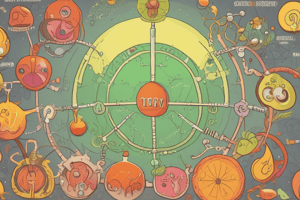Podcast
Questions and Answers
Which of the following is NOT a product of the citric acid cycle?
Which of the following is NOT a product of the citric acid cycle?
- CO₂
- ATP (correct)
- NADH
- FADH₂
In which cellular compartment does the citric acid cycle take place?
In which cellular compartment does the citric acid cycle take place?
- Mitochondrial matrix (correct)
- Cytosol
- Endoplasmic reticulum
- Nucleus
What is the primary function of the citric acid cycle?
What is the primary function of the citric acid cycle?
- To release energy for ATP synthesis (correct)
- To transport electrons across the mitochondrial membrane
- To generate ATP directly
- To break down glucose
What is the role of GDP-forming succinate dehydrogenase in the citric acid cycle?
What is the role of GDP-forming succinate dehydrogenase in the citric acid cycle?
Which of the following is NOT an intermediate of the citric acid cycle?
Which of the following is NOT an intermediate of the citric acid cycle?
In the citric acid cycle, which of the following correctly represents the order of steps involving the oxidative decarboxylation reactions?
In the citric acid cycle, which of the following correctly represents the order of steps involving the oxidative decarboxylation reactions?
Which of the following statements accurately describes the role of the Krebs cycle in cellular respiration?
Which of the following statements accurately describes the role of the Krebs cycle in cellular respiration?
Which of the following molecules is directly involved in the formation of citrate during the Krebs cycle?
Which of the following molecules is directly involved in the formation of citrate during the Krebs cycle?
In which part of the eukaryotic cell does the Krebs cycle take place?
In which part of the eukaryotic cell does the Krebs cycle take place?
Which of the following is NOT a direct product of the Krebs cycle?
Which of the following is NOT a direct product of the Krebs cycle?
Flashcards are hidden until you start studying
Study Notes
The Krebs Cycle: A Central Process in Cellular Respiration
The Krebs cycle, also known as the citric acid cycle or the tricarboxylic acid (TCA) cycle, is an essential component of cellular respiration in organisms that consume oxygen. Discovered by Sir Hans Krebs, this cyclical process takes place within the mitochondria, specifically in the mitochondrial matrix in eukaryotic cells. The cycle involves a series of oxidation-reduction reactions that yield high-energy molecules, such as ATP and NADPH, while generating carbon dioxide (CO₂) as a byproduct.
Understanding the Citric Acid Cycle
The citric acid cycle consists of eight main steps:
-
Acetyl-coA formation: The cycle begins with the combination of acetyl-coA, derived from the breakdown of glucose, with oxaloacetate, a four-carbon molecule.
-
Formation of citrate: The resulting molecule, citrate, undergoes rearrangement to form isocitrate.
-
Isocitrate oxidative decarboxylation: Isocitrate is converted to alpha-ketoglutarate through a series of reactions involving NADH and FADH₂. The waste product CO₂ is released.
-
Alpha-ketoglutarate oxidative decarboxylation: Alpha-ketoglutarate is further oxidized to succinyl-CoA, while producing another high-energy electron carrier, NADH.
-
Formation and degradation of succinate: Succinyl-CoA is converted to succinate, two molecules of ATP are produced, and CO₂ is generated.
-
Succinyl-CoA synthesis: Succinate is converted back to succinyl-CoA through the action of a specific enzyme, GDP-forming succinate dehydrogenase.
-
Formation of fumarate and oxaloacetate: Fumarate is produced from succinyl-CoA in another series of reactions involving NADH and FADH₂. Oxaloacetate is regenerated.
-
Regeneration of acetyl-coA and entry into the cycle again: The final step involves rearrangement of fumarate to malate, which is then oxidatively decarboxylated to regenerate oxaloacetate. Thus, the cycle begins again with the entry of acetyl-CoA into the first reaction.
Throughout these processes, electron shuttles such as NADH and FADH₂ carry high-energy electrons from the oxidation of nutrients to the end of cellular respiration. The final step of cellular respiration, oxidative phosphorylation, relies on these electron shuttles to drive the synthesis of ATP molecules using the energy generated by the citric acid cycle.
Studying That Suits You
Use AI to generate personalized quizzes and flashcards to suit your learning preferences.




